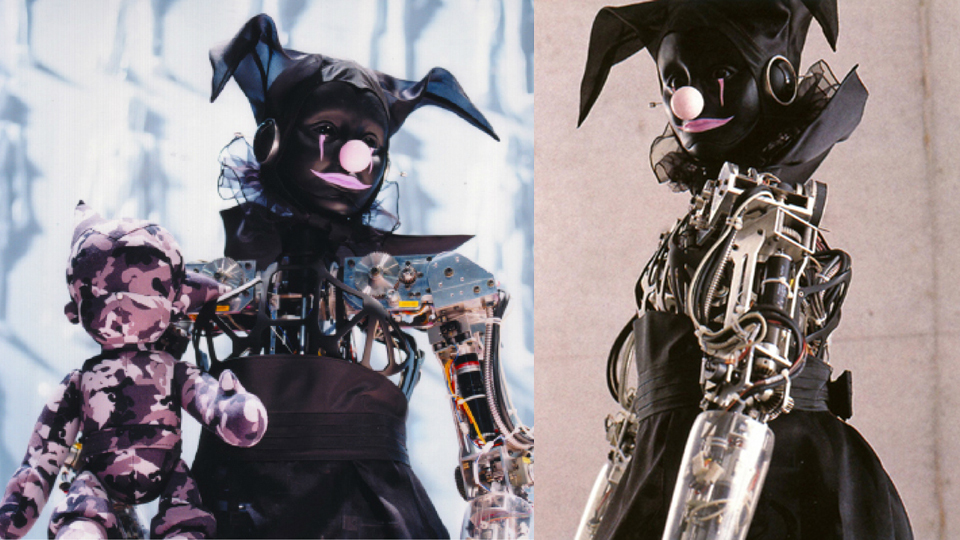P-noir(Pierrot-noir)
2001
CD:Tatsuya Matsui
CCD: Tatsuya Matsui
D: Tatsuya Matsui, Hiroyuki Hoshino
TC: Riso Kagaku Corporation, CINQ-ART CO.,LTD
P:MORI YUTAKA
In this project, I tried to draw a conclusion concerning my own question, “What do people see in humanoid robots?” We produced “PINO,” and were demonstrating it all over the world. We obtained people’s approval everywhere, but a key issue that the robot really intended to present was not brought up. The audience was only excited about how the robot made movements similar to those of a human being. Looking at that sight and sensing differences between their reactions and my concern, my awareness of the issue increased. I calmly accepted the fact that the greatest function of a humanoid robot at that time was the role of a clown.
Therefore, though I admit that there was partly an emotional reason, I developed a black pierrot robot that could dance with a human by detecting his or her movements through a variety of sensors and making an appropriate selection from the data of movements provided beforehand. “P-noir” is a non-creative man-made object that can act only as programmed. Unusual elements are technically connected in the design of “P-noir,” in contrast to “Design of weakness” for “PINO.” A female clown, black color, and silicon material give people an impression that something is wrong. This robot alternately uses faces of two kinds, laughing or sobbing, has some degree of freedom, and shows a variety of movements. As it dances, the music box plays Chopin’s “La Chanson De L’adieu” (It signifies my farewell to “PINO” that was developed commercially.) The audience who saw this dancing pierrot found something surreal, something out of place between a robot and the role of a clown, and they began to think seriously about “functions and possibilities of a humanoid robot in the future,” as we had expected. The relationship between myself and the society that started with “ PINO” resembles “Satyricon” directed by Federico Fellini.
Therefore, though I admit that there was partly an emotional reason, I developed a black pierrot robot that could dance with a human by detecting his or her movements through a variety of sensors and making an appropriate selection from the data of movements provided beforehand. “P-noir” is a non-creative man-made object that can act only as programmed. Unusual elements are technically connected in the design of “P-noir,” in contrast to “Design of weakness” for “PINO.” A female clown, black color, and silicon material give people an impression that something is wrong. This robot alternately uses faces of two kinds, laughing or sobbing, has some degree of freedom, and shows a variety of movements. As it dances, the music box plays Chopin’s “La Chanson De L’adieu” (It signifies my farewell to “PINO” that was developed commercially.) The audience who saw this dancing pierrot found something surreal, something out of place between a robot and the role of a clown, and they began to think seriously about “functions and possibilities of a humanoid robot in the future,” as we had expected. The relationship between myself and the society that started with “ PINO” resembles “Satyricon” directed by Federico Fellini.

